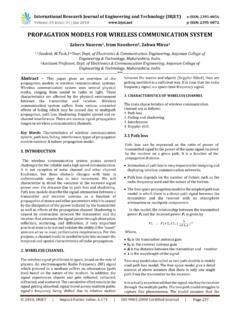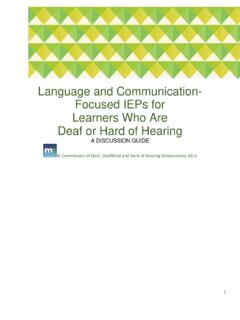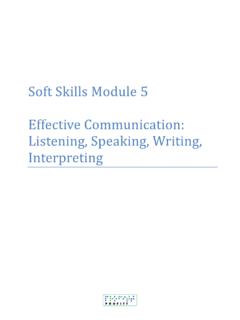Transcription of Theories and models in communicating health messages
1 Learning objectives: Define the term communication and identify components of the com-munication process in a health promotion context. Explore communication theory in relation to health promotion practice. Apply theoretical models of health promotion to the health promotionand health education has an essential role in any action that aims to improve health . It isdifficult to imagine how a message could be delivered to promote healthy choicesif we could not communicate. The communication process is a multi-dimensionaltransaction influenced by a variety of factors. In health promotion work the successfulexchange ofinformation between the practitioner and target audience is an area thathas received mixed attention. Most commonly the emphasis on theory is clear, but theapplication of theory to practice is limited. This chapter introduces five theoreticalmodels that can be applied to health promotion work.
2 This chapter will seek to bridgethe theory-practice gap using a range of examples enabling the practitioner to linktheoreticalmodels to and modelsin communicatinghealth messagesNova 1/18/2007 6:49 PM Page 5 communication DEFINEDC ommunication is a transactional process and in a health context it is an importantpart of health promotion work. communication according to Minardi and Reily(1997) is an essential, instrumental and purposeful process. The communicationtransaction is one of sharing information using a set of common rules (Northouseand Northouse 1998). In health promotioncommunication is a planned process(Kiger 2004). The effectiveness of this planned process comes to fruition when theaudience has achieved, acted on or responded to a OF COMMUNICATIONThe basic representative modelof communication is usually conceptualized as aone-way flow process consisting of a sender, message and receiver (see Figure ).
3 In addition to this, forth and fifth variables can be added: complete understand-ing by that receiver and feedback to the communicator. These last two variablesare important for health communication as they imply two-way communication ,thus moving away from the traditional concept of one-way communicationtowards multi-way communication . It is also important to remember that commu-nication is a cyclic process involving a series of actions, thus a modified model canbe represented as circular (see Figure ).FACTORS INFLUENCING COMMUNICATIONThe multidimensional and dynamic nature of communication means that transac-tions contain other aspects that influence communication . Watzlawick et al.(1967) break communication down into content and relationship . The content includes the message, the words and the information transmitted. The relation-ship consists of the dynamics between those involved in the communicationtransaction-the communicator(s).
4 This breakdown has the advantage identifyingthe content and the relationship between the sender and receiver separately. InCommunicating health : Strategies for health Promotionthe main sender is thehealth practitioner and the receiver is the intended audience (who will be discussedin more detail in Chapter 2). The content is currently of considerable interest inthis HEALTH6 SENDERMESSAGERECEIVERF igure The sender, message and receiver 1/18/2007 6:49 PM Page 6 The content of a message contains verbal and non-verbal communication . Verbalcommunication is the words, sentences and phrases used (Minardi and Reily 1997).Non-verbal communication , according to Ellis and Beattie (1986), contains the fourelements of prosodic, paralinguistic, kinesics and standing features: Prosodic elementsinclude intonation and rhythm. These can influence how the sender deliversthe message and the receiver interprets it.
5 For example, comprehension would alter if thesender of a message spoke quickly or slowly. Paralinguistic featuresinclude vocal but non-verbal expressions like mmm or ahhh . These canalter the way messages are communicated, particularly in relation to the prosodicfeaturesdescribed above. Kinesic elementsinclude body language, eye contact, posture or gestures. For example, differ-ent interpretations of messages would be transmitted by a sender who was trying to maintaineye contact as opposed to a sender who was looking at their feet. Standing featuresinclude factors such as appearance. Some people have pre-conceived notionsof what practitioners who deliver health information should look like. This can include their dress,gender, ethnic group and other appearance-related and lexical content of the message is also important. Lexical content,which literally means the words, can be used positively or negatively.
6 Using wordsfrom complex medical technology or abbreviating key terms can confuse messagesand exclude the target audience, whereas using repetition has been positivelyfound to influence communication (Pechmann and Reibling 2000).As a health practitioner, the communication method will alter the importance ofadditional factors such as lexical content and body language. The communicationTHEORIES AND MODELS7 SenderMessageReceiverUnderstanding FeedbackFigure communication as a multi-way process 1/18/2007 6:49 PM Page 7process will dictate the aspects that are the most important. If you are sendingevery house in one area an information document about preventionoffood- relatedillness and hence have minimal contact with the client group, your appearance andeye contact will be of little importance. If you are delivering a brief one-to-oneintervention on stopping smoking in a health care setting your verbal communica-tion, eye contact or appearance will be IN health PROMOTIONC ommunication in health takes place on many levels, including individual, group,organization, community or mass-media.
7 communication in health can be definedin much the same way as communication has generally been defined: a transac-tional process. The main difference in communicating health is that the focus is nota general one but one specific to health information. Kreps (2003) summarizes theaddition of health to the definition of communication as a resource that allowshealth messages (for example prevention, risk or awareness) to be used in the edu-cation and avoidance of ill health . This broad definition incorporates the fact thathealth communication can take place at many levels and embodies a holisticapproach to health : How are health promotion messages communicated?There are a number of ways (or mediums ) that can be used for communicatingmessages. Many of these can be used in communicating health Think of as many ways of communicating information as you Which methods are most popularly used in communicating health promotionmessages?
8 communication methods can be divided into one of five categories: intrapersonal,interpersonal, organizational, community and public/mass communication . Figure these five hierarchical categories and gives examples of the type of com-munication methods that can be included in these categories. Intrapersonal incor-porates internal communication . This includes what we think or listen to communication is communication on a personal level. This includesone-to-one communication or small group communication . Organizational com-munication includes communication in an organization, both formal and informal. Community communication includes mediums that are used in community set-tings, for example local radio and newspapers. Public/Mass communication islarge-scale and includes national and international HEALTH8 1/18/2007 6:49 PM Page 8 models AND Theories OVERVIEWThe UK government Choosing health : making healthy choices easierwhite paper(DOH 2004) identifies one fundamental and important problem with healthmessages: that it is not a lack of information in health , but that it is inconsistent,uncoordinated and out of step (DOH 2004: 21) with the way the population livetheir lives.
9 This suggests perhaps that despite efforts from health practitioners,some messages are not as effective as they could Population Reference Bureau (2005) in the US suggests that human behav-iour is the central factor in most leading causes of mortalityand morbidity. Theyadvocate that behaviour change strategies should be at the forefront of any attemptsto reduce mortality and morbidity. Being able to predict behaviour makes it easierto plan an intervention (Naidoo and Wills 2000). Therefore the first stage of anycommunication campaignis to analyse the behavioural aspects of the healthproblem (Atkin 2001).In addition it is proposed that if we can understand factors that influence behav-iour we will be in a better position to devise strategies and formulate methods thatwill achieve our health educationgoals no matter what our philosophy or whatmodel we choose to follow (Tones and Tilford 1994: 83). Theoryenables the prac-titioner to predict the outcomes of interventions and the relationships betweeninternal and external variables.
10 Underpinning communication in health promotionshould be an understanding of how and why people change their behaviours andat what point of intervention it is best to target a message. This allows identifica-tion of the actions needed to change that behaviour and highlights the pathways ofinfluence that hinder (or promote) that behaviour. Theories do not specifically identify an intervention to follow. Instead theygenerate a series of ideas for a theory-led intervention to adopt. There are severalTHEORIES AND MODELS9 Figure communication in five categories CommunicationcategoryExample of communication mediumIntrapersonalInternal communication (for example, what we think, when welisten to an innervoice)InterpersonalOne-to-one, small groups, emails, telephone calls and otheractivities that allow personal listening and response OrganizationalLectures, seminars, debates, meetings, memos, intranets,newsletters, workshops, displaysCommunityLocal radio, talks, seminars, debates, local newspapers, billboards, bus wraps, health fairsPublic/MassNewspapers, television, digital television, national radio, Internet,CD-ROMs, mobile phones 1/18/2007 6:49 PM Page 9theoretical models that identify influences in the behavioural change are then selected according to what the practitioner wishes to achieve.
















